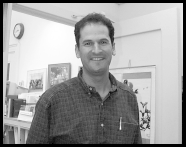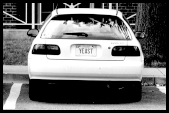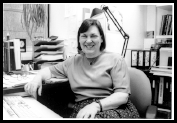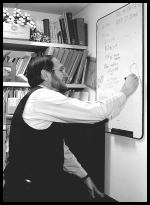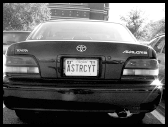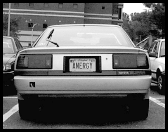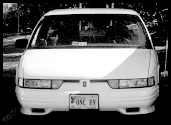NIH'S VANITY FARE
| I |
VECTORS AND VEHICLES
VAXIN8 is on the Maryland Historic Vehicle license plate on the 1963 Landrover Series IIA 88 belonging to David Kaslow, head of NIAID's Malaria Vaccines Section in the Laboratory of Parasitic Diseases.
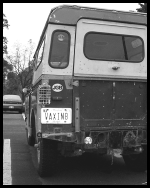 |
The latest twist Kaslow is pursuing is a human vaccine to block transmission of the malaria sporozoan via its mosquito vector.
His plan is to create a vaccine that would generate antibodies to the parasite's gametes - the stage that is picked up by mosquitoes from infected individuals. When the mosquito takes a blood meal from a person who received this vaccine, the antibodies in the human blood would neutralize any parasite gametes the mosquito might be carrying, preventing zygote formation in the mosquito and any further transmission.
David Kaslow |
RISING STAR
It seems only natural that Enrico Cabib, chief of NIDDK's Morphogenesis Section in the Laboratory of Biochemistry and Genetics, should bear the simple and unassuming declamation YEAST upon his license plate. Having worked intimately with this quiet member of the fungal kingdom for nearly 50 years, Cabib has developed a fondness for yeast that transcends beer brewing or bread baking. "Yeast is so small and defenseless," he says, "someone should vouch for it!"
Throughout a career he describes as taking him from being "a poor chemist to not-so-bad enzymologist to bad cell biologist," yeast has been Cabib's constant companion, first as a source of raw materials, such as sugar nucleotides, later for enzymes, and most recently as a tool for studying the molecular biology of morphogenesis.
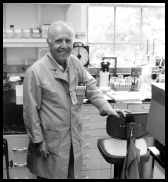 |
Enrico Cabib in his lab (left) |
Looking back a half-century before his own work started, Cabib notes that 1997 marks the 100th anniversary of modern biochemistry, a field that in his estimation owes its birth to his beloved YEAST, since it was extracts of yeast that Eduard Buchner used to accomplish his groundbreaking in vitro fermentation of glucose.
GABA-FEST
In 1989, looking for a focus for his lab's research, Jeffery Barker, chief of NINDS' Laboratory of Neurophysiology, settled on GABA, the neurotransmitter that regulates inhibitory and excitatory functions in the brain.
Trained as a physician, but propelled by an intellectual curiosity that, he says, surpassed his bedside manner, Barker came to NIH in 1969 and has worked on the physiology of the brain ever since. He's stayed one step ahead of the rapidly expanding field by putting his clinical background to good use and by jumping into flow cytometry in its infancy to elucidate and compare phenotypes of individual cells in the brain - critical in the study of development.
 |
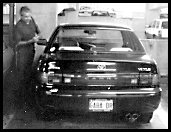 GABA DR Jeffery Barker at |
"If I should indulge myself in vanity, then let it reflect the scope of the lab," Barker says. And thus shall Jeffery Barker be known as GABA DR.
CELL CYCLES
ASTRCYT and ANERGY belong to husband-and-wife scientists Joan Schwartz and Ron Schwartz. The Schwartzes got their first vanity plates when they lived in Washington, D.C., where NINDS' Joan Schwartz had "NEURON" and NIAID's Ron Schwartz had "T CELL."
|
When they moved to Maryland in 1992, however, Joan Schwartz found that someone already had "NEURON," and she decided to shift the license plate spotlight to her astrocyte work.
Her lab is currently exploring the modus operandi of reactive astrocytes - enlarged cells in the brain formed in response to even subtle injury. Reactive astrocytes may persist long after an injury has healed and have a distinctive pattern of cytokine production and response to neurotransmitters and cytokines - a pattern similar to the signature of immature astrocytes found in neonates.
Working with cultures of normal and reactive rat astrocytes, her team is now focused on identifying factors that cause a normal astrocyte to become reactive and vice versa.
|
His
Even for the man who has it emblazoned on his license plate, clonal T cell ANERGY is still a poorly understood immunological phenomenon - an unresponsiveness that Ron Schwartz and his postdocs induced in some cultured T cells back in 1987.
Cells in this state have essentially turned themselves off - they cease dividing and producing IL-2 - but don't go totally quiescent. They can still make gamma interferon, for example.
ASTRCYT and ANERGY appear |
By 1990, Ron Schwartz recalls, things started to go crazy. "Anything related to tolerance got called anergy," he says, which led to some backlash against overuse of the term.
As researchers began to understand that normal activation of T cells requires two signals, Ron Schwartz and his coworkers realized that one way in which T cells could go anergic was by receiving only the antigen-specific signal and not the co-stimulatory signal. To date, clonal anergy remains a lab phenomenon, but Ron Schwartz's lab, as well as others, is avidly looking for animal models of anergy and trying to ascertain under what circumstances it would likely play a part in the immune system in vivo.
If ANERGY is poorly understood by immunologists, it's a total enigma to ordinary mortals who glimpse the license plate. Occasionally Ron Schwartz gets an opportunity to educate a few souls about ANERGY, but most folks just assume it has something to do with energy.
Ron Schwartz says ANERGY's inaccessiblity contrasts with his old "T CELL" plates, which were readily understood in this age of AIDS. He recalls one time when he'd parked "T CELL" in Georgetown to go to a movie and returned to find a young man sitting on his car. He yelled at the fellow to get off.
The young man - who turned out to be a medical student - responded defiantly, "Well, what kind of a T CELL are you, anyway, a suppressor?" Without a pause and with ostensibly mock gruffness, Ron Schwartz replied, "No, a killer." This got the student off his car and left everyone laughing.
Helen Mayberry |
Helen Mayberry got her ONC RN vanity plate a few years back. She says that most people seem to recognize that RN signifies nurse, but few make the connection between ONC and oncology or cancer.
Mayberry has been a nurse since 1985, specializing in adult oncology for the last 10 of those years. In 1996, the Fairfax, Virginia, native stepped away from bedside patient care at George Washington University Hospital to join the NIH Clinical Center as a clinical nurse specialist. In this capacity, Mayberry presides over a team of attending nurses, ensuring that they have the skills and knowledge necessary to perform patient care within the letter of various research protocols - a responsibility that underwrites the validity of experimental data.
A full plate |
"It's a unique opportunity," she reflects, "to see the human spirit rise to the occasion, as patients find ways perhaps they didn't even know about in themselves to deal with their cancer."
Despite the physical and emotional demands of her job, Mayberry feels privileged, she says, to witness the personal growth of individuals who come from very diverse backgrounds to NIH - often for uncertain experimental treatment.
